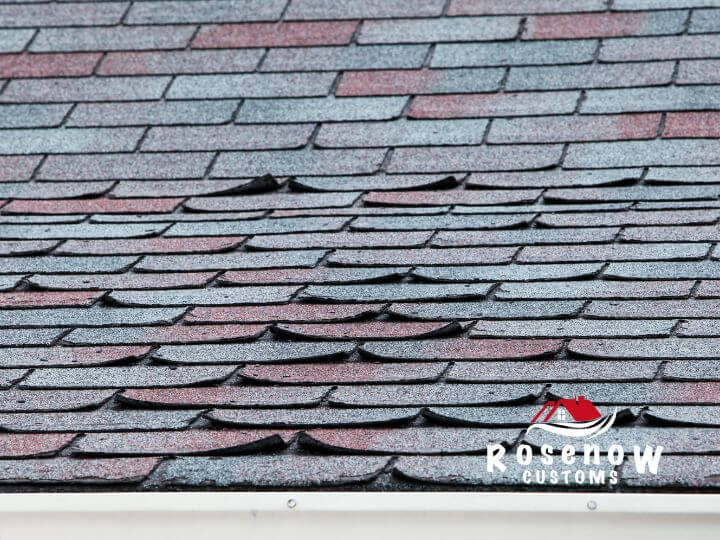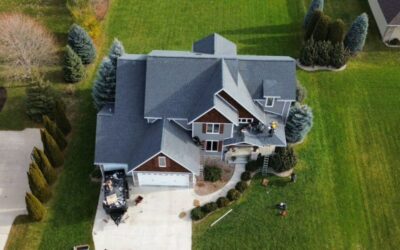Weather-induced roof damage is a common, yet often overlooked, consequence of severe weather conditions. This type of damage can significantly impact the structural integrity of your home, leading to costly repairs if not addressed promptly. The expertise of Rosenow Customs in Roof Maintenance becomes invaluable in managing and mitigating the effects of such damages effectively. This article will guide you through understanding what weather-induced roof damage is, how to recognize its signs, evaluate its extent, and finally, how to address it effectively. Whether you’re a homeowner looking to maintain your property or a professional in the construction or real estate industry, this comprehensive guide will provide you with the knowledge you need to tackle weather-related roof issues head-on.
Understanding Weather-Induced Roof Damage
Your roof serves as the primary line of defense against the elements, enduring the harsh impact of various weather conditions. Over time, this can lead to significant damage. This guide delves into the intricacies of weather-induced roof damage, highlighting its implications and the crucial role of early detection. We aim to equip you with the knowledge to identify the signs, assess the severity, and decide on the most suitable course of action. Whether you’re a homeowner striving to extend your roof’s lifespan or a potential buyer seeking essential information, this comprehensive guide on weather-induced roof damage is designed for you.
Concept of Weather-Induced Roof Damage
Weather-induced roof damage is the term used to describe the structural or aesthetic harm inflicted by severe weather conditions such as rain, wind, snow, hail, or extreme temperatures. The extent of this damage can vary greatly, from minor cosmetic issues like discoloration to major structural problems like leaks or even roof collapse.
For example, rainfall and snow can result in water seeping into your home, leading to rot, mold, and interior damage. High winds have the potential to lift or even rip off shingles, exposing your roof. Hail can crack, displace, or dent your shingles, weakening your roof’s protective layer. Extreme temperatures can induce thermal shock, causing roofing materials to expand and contract, leading to cracks or splits.
Several factors can increase your roof’s vulnerability to weather damage. These include the type of roofing materials used, the age and maintenance history of your roof, and your home’s geographical location. Understanding the different forms of weather-induced roof damage is essential for early detection and prevention, ultimately ensuring the longevity and structural integrity of your roof.
The Importance of Detecting Weather-Induced Roof Damage
Spotting weather-induced roof damage at an early stage is vital for preserving the structural integrity, comfort, and value of your home. Timely detection paves the way for swift remedial measures, potentially saving you from more expensive repairs or a total roof replacement down the line.
Consider this: undetected roof damage can escalate to severe structural problems. Persistent leaks and ongoing exposure to harsh weather conditions, coupled with the resultant rot, can compromise the strength of your roof, leading to partial or even total collapse. This not only threatens the structural soundness of your home but also poses a considerable safety risk to its occupants.
Moreover, such damages can adversely affect your home’s energy efficiency. Damages like cracks and holes facilitate the uncontrolled flow of air, forcing your heating and cooling systems to work overtime to maintain a comfortable indoor climate. The result? Increased energy consumption and a spike in your utility bills.
In addition, roof damage can create a conducive environment for mold growth, thanks to the persistent damp conditions caused by leaks. Mold infestations not only mar the aesthetic appeal of your home but also pose serious health risks, including allergies and respiratory problems.
Lastly, a well-kept roof enhances the curb appeal and overall value of your property. Visible roof damage can detract from your home’s aesthetic appeal and depress its market value.
In essence, early detection of weather-induced roof damage not only saves you money on extensive repairs but also promotes a healthier, safer, and more comfortable living environment.
Recognizing Signs of Weather-Induced Roof Damage
Maintaining the health of your roof requires prompt identification of potential signs of weather-induced damage. Spotting these signs can rely on both external indicators visible on the roof itself and internal signs observable within your home. Bear in mind that some damages may not be immediately apparent as they can develop subtly over time. However, being aware of what to look for can expedite detection and thus enable timely intervention. In the following sections, we’ll explore specific signs to be aware of, ranging from overt signs such as shingle damage and water leaks to more covert signs like structural deformations.
Shingle Damage
Your roof’s shingles are the frontline defense against the elements, and their condition can provide crucial insights into the health of your roof. Weather phenomena such as fierce winds, torrential rain, and hail can wreak havoc on your shingles, leading to noticeable damage. Here are some key indicators of shingle damage to be aware of:
Missing Shingles: High winds and violent storms can dislodge shingles, leaving sections of your roof bare and vulnerable. This exposure can escalate roof deterioration by allowing water and other elements to infiltrate the roof’s underlayers.
Curled or Buckled Shingles: Shingles can curl or buckle due to prolonged exposure to fluctuating weather conditions. This distortion often indicates that the shingles are past their prime, losing their weatherproofing capabilities.
Bruised or Dented Shingles: Hail can inflict small dents or bruises on your shingles. These seemingly minor damages can undermine the shingle’s protective surface, potentially leading to leaks over time.
Granule Loss: Intense rain and hail can strip shingles of their granules, which serve as a protective shield against UV rays, enhance fire resistance, and contribute to the shingle’s color. Look for granule buildup in your gutters and downspouts as a sign of this damage.
Cracked Shingles: Weather-related stress can cause shingles to crack, providing a pathway for water to infiltrate the roof structure, which can lead to significant damage.
By being vigilant for these signs, homeowners can identify weather-induced roof damage early, containing the issue before it escalates and potentially saving on costly, extensive repairs.
Indoor Signs: Leaks and Water Damage
Not all signs of roof damage are visible from the outside. Some symptoms may manifest inside your home, with water leaks and damage being the most common indicators of a weather-beaten roof. Here are some signs to watch out for:
Ceiling Stains: Discolorations or stains on your ceiling are often a telltale sign of water leakage. These stains are typically yellow-brown and can appear on both the ceiling and adjacent walls.
Dripping Water: Water droplets falling from your ceiling during or after a rainstorm are a surefire sign of a roof leak.
Mold Growth: Mold growth, particularly in the corners of ceilings or walls, is often a consequence of water seepage due to roof damage.
Peeling Paint: Peeling or bubbling paint on your interior walls or ceiling is often a result of moisture infiltration through a damaged roof.
Unusual Odors: Musty or damp smells inside your home may signal trapped moisture from a leaky roof, leading to the formation of mold or mildew.
These signs should not be overlooked as they could point to more extensive roof damage that, if neglected, could lead to significant structural issues. In the worst-case scenario, these leaks can damage not just your home’s structure, but also your furnishings and personal items, increasing your repair costs.
Structural Issues: Sagging and Deformations
Weather-induced roof damage can sometimes escalate, leading to serious structural issues that demand immediate attention. Two key structural concerns to be aware of include:
- Sagging: A sagging roof is a clear warning sign of potential structural damage. This issue often stems from water damage and can manifest on the roof’s surface or, in severe cases, impact the underlying support structures. A sagging roof is a pressing concern that could lead to a roof collapse if not promptly addressed.
- Deformations: Deformations are another indicator of significant weather-induced roof damage. These can appear as bulging patches on your roof surface, irregularities in the roof line, or warping of roof components. Deformations suggest that the roof structure is under considerable stress, which, if left unaddressed, could jeopardize the structural integrity of your building.
Both sagging and deformation are signs of serious roof damage. It’s crucial to seek professional help immediately upon noticing these issues. Delaying action could lead to more extensive and expensive repairs, or in the worst-case scenario, catastrophic damage to your home.
Evaluating the Extent of Roof Damage
Once you’ve identified potential signs of weather-induced roof damage, the next step is to gauge the severity of the damage. This evaluation will guide the necessary course of action—be it repair or replacement. This section will walk you through the process of conducting a basic home inspection and underscore the invaluable role of professional roof inspectors in providing a comprehensive and accurate assessment of your roof’s condition. Remember, accurately determining the extent of damage is key to ensuring the safety and longevity of your roof.
Basic Home Inspection
Initiating the evaluation of roof damage begins with a fundamental home inspection. This involves a careful visual survey of your home’s interior and exterior for any indications of weather-induced roof damage:
- Exterior Inspection: Conduct a meticulous examination of your roof to spot any visible damage. Keep an eye out for missing, curled, or damaged shingles, and be particularly vigilant for shingle granules in your gutters or downspouts, as these can be a telltale sign of wear and tear. Also, be on the lookout for any sagging or deformations in the roof or roofline.
- Interior Inspection: Shift your inspection indoors and scrutinize ceilings, walls, and attics for any signs of water leakage or damage, such as damp spots, discoloration, or mold growth.
Ensure you use a safe method to access your roof, like a secured ladder or roof watchtower. If it’s unsafe or you’re uncomfortable conducting the inspection yourself, it’s advisable to hire a professional.
Remember, a basic home inspection can only reveal so much. A professional roof inspector possesses the necessary tools and expertise to conduct a more thorough inspection, uncovering underlying issues that may not be apparent to the untrained eye.
Role of Professional Roof Inspectors
While a fundamental home inspection can help identify visible signs of weather-induced roof damage, it may not uncover hidden or emerging issues. This is where the expertise of professional roof inspectors becomes invaluable. These specialists are trained and experienced in conducting detailed roof inspections. Here’s why their role is crucial:
- Detailed Evaluation: Professional inspectors perform an exhaustive examination of your roof. Their knowledge of intricate roofing systems and experience in detecting subtle damage allows them to identify not only obvious issues but also early signs of potential future problems.
- Expert Advice: Upon completion of the evaluation, they provide a comprehensive damage report and guide you through the necessary steps, advising whether repair, restoration, or replacement is the most suitable solution.
- Preventative Maintenance: Regular inspections by professionals can help identify minor issues before they evolve into more serious problems, thus averting potentially expensive repairs in the future. Their role is vital in preserving the lifespan of your roof.
- Safety: Roof inspections can be hazardous. Professional inspectors are equipped with the appropriate safety gear and training to conduct the inspection safely, without posing a risk to themselves or others.
Engaging a professional roof inspector not only guarantees the safety of your roof but also saves you time and future expenses related to extensive damages.
Addressing Weather-Induced Roof Damage
Once you’ve pinpointed and assessed the scope of the weather-related roof damage, it’s vital to tackle the problem head-on. This segment will provide guidance on determining the appropriate time for repairs and when a complete roof replacement is unavoidable. By making well-informed choices, you can reinstate your roof’s functionality, safeguard your home, and circumvent unnecessary financial burdens.
When to Repair
The decision to repair your roof hinges on the severity and type of damage. Here are some situations where a repair might be the most suitable course of action:
- Minor Damage: When the weather-related damage is relatively insignificant—such as a handful of missing, cracked, or curling shingles, a repair is likely to be the most cost-effective solution.
- Localized Damage: If the damage is limited to a small section of your roof, mending the affected areas can rectify the issue without necessitating a full roof replacement.
- Recent Roof: If your roof is relatively new or in the middle of its expected lifespan, addressing isolated issues could be a more practical alternative to replacing the entire roof.
- Leaks: Occasionally, even multiple leaks can be rectified without a complete replacement. This is particularly true if the leaks are due to problems like loose flashings or minor shingle damage.
While repairs are often more affordable, they must be carried out professionally to prevent recurring issues or more extensive damage down the line. Always seek advice from a roofing professional to determine the most effective and long-lasting solution.
When to Replace
There are instances when a simple repair won’t suffice, and a complete roof replacement becomes necessary. This decision, while significant and more expensive, can often be the most financially sensible choice over time. Here are some scenarios where you might need to consider a full roof replacement:
Advanced Age: The typical lifespan of a roof ranges from 20 to 30 years. If your roof is reaching or has surpassed this age, it might be more economical to replace rather than repair it.
Widespread Damage: When a substantial part of your roof has been damaged due to severe weather conditions or lack of maintenance, a repair might not be enough. In such cases, replacing the entire roof can offer a more durable solution and peace of mind.
Severe Structural Damage: If your roof exhibits signs of serious structural damage, such as significant sagging or extensive deformation, replacement is often the safest and most cost-effective route.
Multiple Shingle Layers: If your roof already has two layers of shingles, which is the maximum recommended, adding a third layer after storm or wind damage is not advisable. In these circumstances, a full roof replacement becomes necessary.
In all these situations, it’s crucial to seek the advice of a professional roofer. They can provide a comprehensive evaluation of your roof’s condition and offer precise estimates for both repair and replacement costs. This expert guidance can help you make a well-informed decision about the best course of action for your specific situation.
1. What are the common Signs of Weather-Induced Roof Damage?
Visible bruising or missing shingles, the collection of granule particles in gutters, leakage, and damp ceiling spots are frequent symptoms of weather-induced roof damage.
2. How does hail contribute to Weather-Induced Roof Damage?
Hail creates a high-impact force that can result in shingle bruising and the loss of granule particles. Hail-induced damage generally degrades the lifespan of a roof.
3. How can one identify wind-induced roof damage?
Signs of wind-generated roof damage include missing or lifted shingles, especially along the edges and near the ridge line, as well as leaks where debris lodged under shingles.
4. Are ice dams indicators of weather-induced roofing damage?
Absolutely. Ice dams obstruct the natural flow of water off the roof. Water that backs-up behind an ice dam can infiltrate a roof surface and cause extensive damage.
5. Does weather-induced roof damage occur immediately?
No, not always. Damage resulting from severe weather conditions such as hailstorms, heavy winds, or ice dams may not be immediately visible, potentially leading to long-term roof complications.
6. How often should one check the roof for signs of weather damage?
Regular roof check-ups, especially after severe weather occurrences, are highly beneficial. Bi-annual inspections or annual professional check-ups help detect early signs of weather-induced damage.





